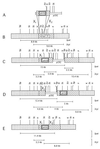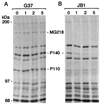Disruption of gene mg218 of Mycoplasma genitalium through homologous recombination leads to an adherence-deficient phenotype
- PMID: 10220448
- PMCID: PMC21846
- DOI: 10.1073/pnas.96.9.5227
Disruption of gene mg218 of Mycoplasma genitalium through homologous recombination leads to an adherence-deficient phenotype
Abstract
Although the complete genome of Mycoplasma genitalium has been sequenced, the functional identification of various genes, including those involved in virulence, has not been accomplished. Further compounding these difficulties has been the failure to develop genetic tools in mycoplasmas that permit the assessment of gene and operon function and regulation. To determine whether homologous recombination could be developed as a tool to analyze the function of genes in M. genitalium, a plasmid that replicates in Escherichia coli but not in M. genitalium was constructed to disrupt the cytadherence-related gene mg218 of M. genitalium. The electroporation of this disruption plasmid into wild-type hemadsorption-positive (HA+) M. genitalium cells permitted the isolation of HA- (strain JB1) and partial HA+ (strains JB2 and JB20) transformants. Analysis of the transformants by Southern hybridization indicated that homologous recombination occurred at the mg218 locus by single-crossover events in JB1 and JB2 and by a double-crossover event in JB20. While integration of the disruption construct abolished the expression MG218 in JB1, strains JB2 and JB20 exhibited a truncated MG218 protein (160 kDa), possibly because of in-frame fusion of the disrupted mg218 gene with sequences downstream of the gentamycin-resistance gene present in the disruption construct. Strain JB1, which lacked MG218, displayed a post-translational defect, being unable to maintain the structural integrity of the major adhesin P140 and its operon-related protein P110, in contrast to JB2 and JB20. It appears that MG218 influences the stability of other cytadherence-related proteins in vivo. Thus, targeted gene disruption through homologous recombination will be a powerful and promising tool for investigating the biology and pathogenesis of M. genitalium.
Figures






References
-
- Lo S-C. In: Mycoplasma: Molecular Biology and Pathogenesis. Maniloff J, McElhaney R N, Finch L R, Baseman J B, editors. Washington, DC: Am. Soc. Microbiol.; 1992. pp. 525–545.
-
- Fraser C M, Gocayne J D, White O, Adams M D, Clayton R A, Fleischmann R D, Bult C J, Kerlavage A R, Sutton G, Kelley J M, et al. Science. 1995;270:397–403. - PubMed
-
- Tully J, Taylor-Robinson D, Rose D L, Cole R M, Bove J M. Int J Syst Bacteriol. 1983;33:387–396.
Publication types
MeSH terms
Grants and funding
LinkOut - more resources
Full Text Sources

